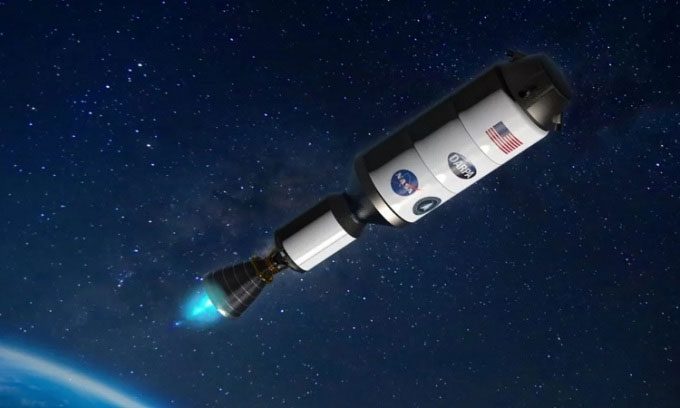NASA and the U.S. military plan to launch a nuclear-powered spacecraft into Earth orbit by late 2025 or early 2026.
The project, named DRACO (Demonstration Rocket for Agile Cislunar Operations), aims to test nuclear thermal propulsion (NTP) technology in space, a revolutionary advancement that promises to help humanity set foot on Mars and other distant planets. The DRACO spacecraft will be developed and manufactured by Lockheed Martin, as announced by the project team on July 26.

Design of the DRACO spacecraft using nuclear thermal rocket engines. (Image: DARPA).
NASA has been interested in NTP technology for a long time. The agency previously intended to launch a crewed mission to Mars using a nuclear spacecraft in 1979 through the NERVA (Nuclear Engine for Rocket Vehicle Application) program. However, NERVA was postponed in 1972. NASA still aims to send astronauts to the Red Planet by the end of the 2030s or the early 2040s. Nuclear thermal propulsion is a significant breakthrough that could make this goal more feasible by cutting travel time between Earth and Mars by half.
Nuclear thermal rockets carry a small fission reactor that releases a tremendous amount of heat when splitting atoms. This heat can be used to convert propellant into gas, causing it to expand and be expelled through a nozzle to produce thrust. This process is different from radioisotope thermoelectric generators (RTGs), a nuclear technology used on spacecraft since the dawn of the space age. RTGs do not provide thrust; instead, they harness heat from radioactive decay to generate electricity for instruments, motors, and various other equipment on the spacecraft.
DARPA and NASA aim to launch the first in-space test version in 2027. However, this timeline could be accelerated. According to Kirk Shireman, Vice President of Lockheed Martin’s Lunar Exploration Campaign, they plan to launch the spacecraft between late 2025 and early 2026. The spacecraft will fly to a relatively high orbit around Earth, between 700 and 2,000 kilometers. At that altitude, the DRACO test vehicle will take at least 300 years to fall back to Earth through atmospheric drag, which is long enough to ensure that all nuclear fuel has been consumed.
The mission team must ensure safety throughout the process. The nuclear engine of DRACO will only be activated once it reaches orbit. During launch, the engine will be equipped with a “poison wire”, a piece of metal that absorbs neutrons to prevent them from triggering a chain reaction. This component acts like control rods in a nuclear reactor on Earth. It is expected that DRACO will operate in orbit for several months and will not carry scientific instruments. Instead, it will demonstrate that the NTP engine can function for extended periods in the space environment.
However, using this engine also requires maintaining hydrogen on the DRACO spacecraft in a supercooled state. The spacecraft will launch with 2,000 kg of hydrogen. According to Dotson, it will include the NTP system and a large tank containing hydrogen fuel.


















































